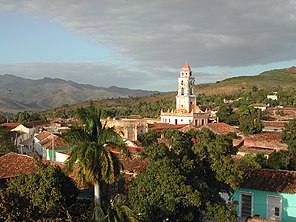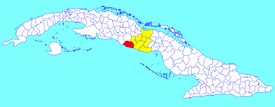Trinidad, Cuba
Trinidad
Villa de la Santísima Trinidad | |
|---|---|
| Trinidad | |
 The Iglesia y Convento de San Francisco in Trinidad | |
|
Coat of arms of Trinidad Coat of arms | |
 Trinidad municipality (red) within Sancti Spíritus Province (yellow) and Cuba | |
| Country | |
| Province | Sancti Spíritus |
| Founded | December 23, 1514[1] |
| Area | |
• Total | 1,155 km2 (446 sq mi) |
| Elevation | 80 m (260 ft) |
| Population (2004)[3] | |
• Total | 73,466 |
| • Density | 63.6/km2 (165/sq mi) |
| Time zone | UTC-5 (EST) |
| Area code | +53-41 |
Trinidad (Spanish pronunciation: [tɾiniˈðað]) is a town in the province of Sancti Spíritus, central Cuba. Together with the nearby Valle de los Ingenios, it has been one of UNESCOs World Heritage sites since 1988.
History
Trinidad was founded on December 23, 1514[1] by Diego Velázquez de Cuéllar under the name Villa de la Santísima Trinidad.[4]
Hernán Cortés recruited men for his expedition from Juan de Grijalva's home in Trinidad, and Sancti Spíritus, at the start of his 1518 expedition. This included Pedro de Alvarado and his five brothers. After ten days, Cortes sailed, the alcayde Francisco Verdugo failing to prevent Cortes from leaving, despite orders from Diego Velázquez.[5]: 49–52
Francisco Iznaga,[6] a Basque landowner in the southern portion of Cuba during the first 30 years of the colonization of Cuba, was elected Mayor of Bayamo in 1540. Iznaga was the originator of a powerful lineage which finally settled in Trinidad where the Torre Iznaga (Iznaga Tower) is. His descendants fought for the independence of Cuba and for annexation to the U.S., from 1820 to 1900.
Trinidad is one of the best-preserved cities in the Caribbean from the time when the sugar trade was the main industry in the region.
Geography
The town proper is divided into the barrios (quarters) of Primero, Segundo and Tercero. The whole municipality counts the consejos populares (villages) of Aguacate, Cabagán, Caracusey, Casilda, Guaniquical, Río de Ay, San Francisco, San Pedro, and Táyaba.[1]
Economy
Nowadays, Trinidad's main industry is tobacco processing. The older parts of town are well preserved, as the Cuban tourism industry sees benefit from tour groups. In contrast, some parts of town outside the tourist areas are very run down and in disrepair, especially in the centre. Tourism from Western nations is major source of income in the city.
Tourism
The city is located on the Caribbean coast near the Escambray Mountains.
Culture
Town
- Plaza Mayor
The Plaza Mayor of Trinidad is a plaza and an open-air museum of Spanish Colonial architecture. Only a few square blocks in size, the historic plaza area has cobblestone streets, houses in pastel colors with wrought-iron grilles, and colonial-era edifices such as the Santísima Trinidad Cathedral and Convento de San Francisco. The Municipal History Museum is in town also.
- Music
There are several casas de musica, including one next to the cathedral in Plaza Major. There are also discothèques, including one in the ruins of a church; another is in a large cave formerly used as a war time hospital.
Region
- Sugar mills
The Valley of the Sugar Mills—Valle de los Ingenios, also a World Heritage Site, has around 70 historic sugar cane mills. They represent the importance of sugar to the Cuban economy since the 18th century.
The valley has la Torre Iznaga, a 45 metres (148 ft) tower built by Alejo Iznaga Borrell [7] in 1816.
- Coasts and beaches
20 kilometres (12 mi) from the city is Topes de Collantes, one of Cuba’s premier ecotourism centres. Another attraction is the Casilda Bay, which attracts both snorkelers and divers.
A nearby islet has pristine beaches. Ancón Beach—Playa Ancón, is a white sand beach and was one of the first new resorts to be developed in Cuba following the 1959 revolution. Along the Ancón Peninsula are three hotels: Hotel Costa Sur (South Coast Hotel), Hotel Ancón, and Brisas Trinidad del Mar.
Demographics
In 2004, the municipality of Trinidad had a population of 73,466.[3] With a total area of 1,155 km2 (446 sq mi),[2] it has a population density of 63.6/km2 (165/sq mi).
Photo gallery
-
Plaza Mayor and Iglesia y Convento de San Francisco
-
Plaza Mayor
-
A typical colonial street in October 2000.
-
Town hall
-
Street
-
Street
-
Street
-
Trinidad just before a storm
-
Children in Trinidad
-
Playa Ancón
-
Plaza Mayor
-
Church of the Holy Trinity, interior view
See also
References
- ^ a b c Guije.com. "Trinidad" (in Spanish). Retrieved 2007-10-07.
- ^ a b Statoids (July 2003). "Municipios of Cuba". Retrieved 2007-10-07.
- ^ a b Atenas.cu (2004). "2004 Population trends, by Province and Municipality" (in Spanish). Archived from the original on 2007-09-27. Retrieved 2007-10-07.
- ^ Template:Es icon History of Trinidad on EcuRed
- ^ Diaz, B., 1963, The Conquest of New Spain, London: Penguin Books, ISBN 0140441239
- ^ Jorge Iznaga. FRANCISCO IZNAGA Iznaga Genealogy (IZNAGA - 1420 - Present), Retrieved 5 December 2012.
- ^ Jorge Iznaga. ALEJO MARIA IZNAGA BORRELL Iznaga Genealogy (IZNAGA - 1420 - Present), Retrieved 5 December 2012.
Further reading
- Totten, Michael J. (January 27, 2014). "The Lost World: Part II". World Affairs Journal. American Peace Society. Retrieved February 1, 2014.
External links
- mycubavisit.com, Online travel guide to Trinidad
- fotopedia.com, Selected photos of Trinidad
- opengalleries.org, Photos of Trinidad
- Typical colonial casa hostal in Trinidad Cuba












